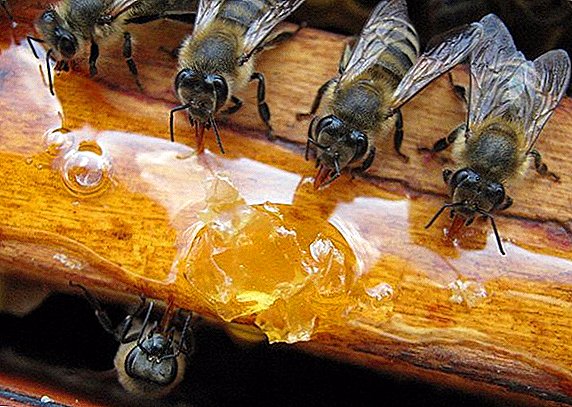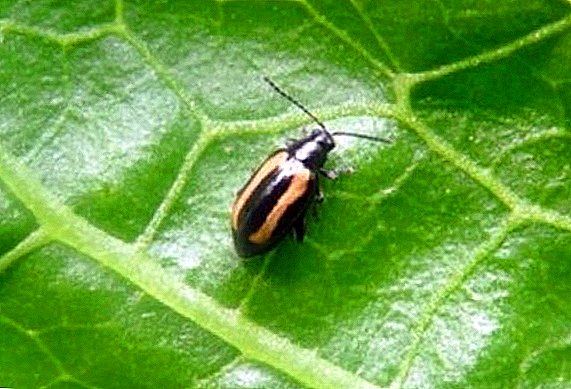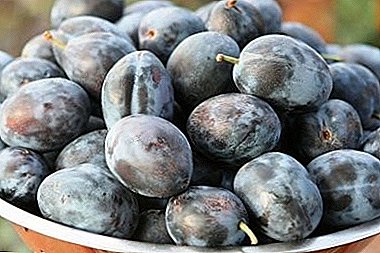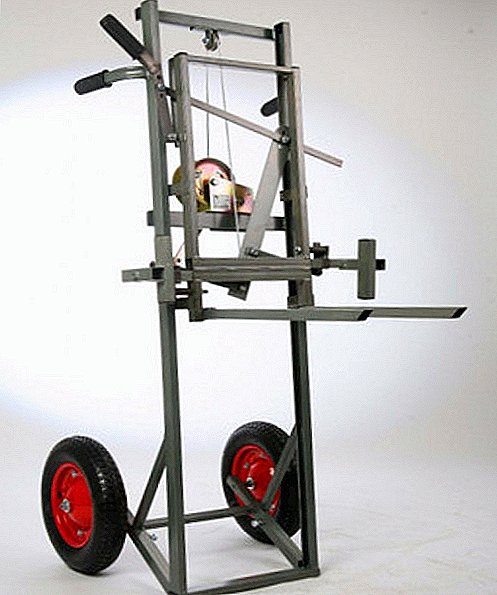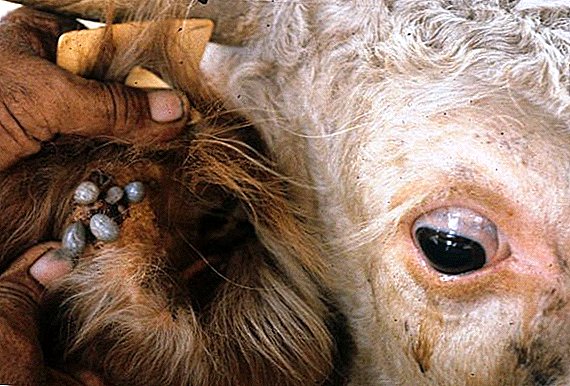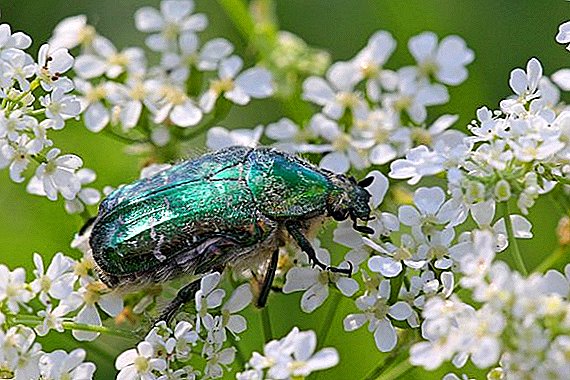 Beetle-bronzovka relatively recently became a headache for gardeners and gardeners. For a long time it was difficult to believe that this unusually beautiful insect with emerald iridescent wings and abdomen is a dangerous pest. The object of his passion are the flowers of fruit trees, vegetables and decorative plants. And he chooses the most beautiful flowers, eating them middle. How to deal with this pest?
Beetle-bronzovka relatively recently became a headache for gardeners and gardeners. For a long time it was difficult to believe that this unusually beautiful insect with emerald iridescent wings and abdomen is a dangerous pest. The object of his passion are the flowers of fruit trees, vegetables and decorative plants. And he chooses the most beautiful flowers, eating them middle. How to deal with this pest?
Golden bronze: description of the pest
The bronze beetle, or bronzovka, belongs to the order of beetles of the platyla family, of the genus cetonia, which means "metal beetle". Biologists distinguish at least five subspecies of this beetle, each of which has several deviations in appearance from the main subspecies. Therefore, the length of the oblong oval body of the beetle can range from 1.3 cm to 2.3 cm. All insects of this genus have front digging legs and antennae, which are hidden on the head under the chitinous shield. A characteristic feature of the golden bronze is the emerald green metallic chitin coating.
Did you know? In fact, the color of the beetle is black. However, the structure of its chitinous coating is complex, refracting light. Therefore, due to the play of the rays laid out on the spectrum, the surface casts emerald green, copper reddish, and sometimes even a blue tint. Such pigmentation is called optical or structural.
 Because of its size and anatomical features, the insect is often referred to as the green Maybot. They belong to the same family, but to different genera. Therefore, to call these two insects by one name is wrong. Especially since they have completely different behaviors.
Because of its size and anatomical features, the insect is often referred to as the green Maybot. They belong to the same family, but to different genera. Therefore, to call these two insects by one name is wrong. Especially since they have completely different behaviors.
So, bronzovki active only in sunny warm weather, although at this time can be slow. In the bright warm sun, they move from bush to bush or from flower to flower. But sometimes they do not have time to navigate and crash into a walking person or animal. They fall on their backs and turn back incredibly long.
Did you know? Those who claim that the green beetle is similar to the May beetle, it is useful to know the differences in the aircraft of beetles. So, if the May flight raises the elytra, then in the bronze they remain on the back, only rising slightly. It releases wings on the sides through a special neckline in the sheaths. No other bug can boast such a flying structure.
The period of activity in the beetle begins from the end of spring and lasts no more than 4.5 months, depending on the region. If the day turned out to be bad weather, the bronze golden insect stays motionless all the day long on the flower, having fixed on it with its front paws and head. At night and during periods of cold snaps, it slides or falls down and buries itself in the ground near the stem and root of the plant. The beetle lives throughout Eurasia, except for deserts and mountain regions.
Features of the life cycle of golden bronze
 Despite the anatomical features of the insect, The life cycle of this large green beetle is typical. Like any other insect, it hatches from the egg, then grows into a larva, turns into a pupa, from which the adult beetle (imago) soon leaves. The duration of this cycle is 2 years.
Despite the anatomical features of the insect, The life cycle of this large green beetle is typical. Like any other insect, it hatches from the egg, then grows into a larva, turns into a pupa, from which the adult beetle (imago) soon leaves. The duration of this cycle is 2 years.
Yellowish-white eggs lay in the soil of the female in early summer. The nests are anthills, black soil, manure heaps. After egg-laying, the females die, and after a couple of weeks white larvae hatch from the eggs. They feed on plant remains and dead roots, they don’t like live plants. Bronze larvae grow very quickly, reaching 6 cm in length. Her legs are very short, so she uses her back muscles for movement, crawling like a worm. Then its transformation processes begin: it takes a C-shape, sheds two times and turns yellow.
Did you know? The larvae of the beetle are not at all interesting for ants, and they easily tolerate their neighborhood in their anthill. Larvae choose their home for wintering. Badgers and foxes know about these features of relationships, therefore, sometimes they tear apart forest anthills in search of such delicacies as plump bronze beetle larvae.
In winter, the larvae descend into the ground below the freezing line and wrap themselves in a cocoon. It is made of dust, earth and a special adhesive mass, which they themselves emit. In the spring, the pupation process begins, and closer to the summer, adult beetles emerge from the cocoon. All summer and until the autumn they actively feed, then burrow into the ground and winter there. Only next year they are ready for mating and laying eggs.
What harm does the bronze garden and garden
 It is enough to know what a bronzka eats to understand the harm it can do to the garden and the garden. Her favorite treat is flowers and a soft ovary, and sometimes juicy soft fruits of fruit trees. Sometimes young shoots and leaves are used, but most of all the beetle likes to climb into the middle of a flower and gnaw its reproductive organs - pistils and stamen. It is clear that after this the flower will dry, and there is no reason to dream of any fruits or the beauty of the garden.
It is enough to know what a bronzka eats to understand the harm it can do to the garden and the garden. Her favorite treat is flowers and a soft ovary, and sometimes juicy soft fruits of fruit trees. Sometimes young shoots and leaves are used, but most of all the beetle likes to climb into the middle of a flower and gnaw its reproductive organs - pistils and stamen. It is clear that after this the flower will dry, and there is no reason to dream of any fruits or the beauty of the garden.
Did you know? Gardeners note that the green beetle, the name of which "bronze" is a great esthete. He prefers to eat the most elegant and light flowers, mostly white and light pink. If there are no such ones on the plot, he will not disdain other young inflorescences, but if he can choose, he will nibble on these first of all.
The consequences of the visit are visible immediately: wilted and dried flowers that lack a core, adult flowers with brown spots and damaged petals, leaves with a green plate gnawed out. Some experts reassure, noting that Bronzovka cannot inflict serious harm to the garden or garden, as it appears on the site after the flowering of vegetable and fruit crops. The beetles themselves are not as voracious as the larvae, and the latter feed on what they find in the compost. But flower growers do not reassure such statements at all. Every year they declare a golden battle to the bronze, sometimes they succeed.
Bronzovka: how to deal with a pest
 Unfortunately, today there are no proven and effective measures to combat the bronze. This pest has occupied gardens and orchards in our strip relatively recently, and some experts still do not see it as a threat. Therefore, no serious research on effective measures to combat it has been conducted. But gardeners and gardeners already have a notion of what a bronzovka is and how to deal with this pest.
Unfortunately, today there are no proven and effective measures to combat the bronze. This pest has occupied gardens and orchards in our strip relatively recently, and some experts still do not see it as a threat. Therefore, no serious research on effective measures to combat it has been conducted. But gardeners and gardeners already have a notion of what a bronzovka is and how to deal with this pest.
Important! Since the methods of struggle are not scientifically justified, it is better to combine them to increase efficiency.
Mechanical way
First of all, it is recommended to give preference to the mechanical method of struggle, because it is safest for soil, plants and other insects. In addition, it is very easy to assemble this beetle by hand due to its particular behavior. With cool weather, it reduces its activity and is completely defenseless. It is enough just to know what a golden bronze looks like to assemble it manually.
It is recommended to do this early in the morning, when the beetle has already climbed out of the ground onto a flower, but is still dazed. If the morning is hot and the insect has already begun the meal, the flowers can be sprayed with cold water. The beetle is removed from the flowers or shaken on a pre-prepared litter, if the invasion is massive. The showered insects are recommended to be folded in a can of kerosene.
Another way - in the late afternoon, when it gets dark, put the lamp on, and under it a can of kerosene. Beetles will fly to the light and fall into the bank, where they die.
Folk methods
 If the bronze-beetle has flown into the garden en masse, the control measures should be more serious. Folk methods recommend spraying the plants to scare away onions, horseradish, garlic, wormwood, tansy, dandelion and other plants with infusions or flocks.
If the bronze-beetle has flown into the garden en masse, the control measures should be more serious. Folk methods recommend spraying the plants to scare away onions, horseradish, garlic, wormwood, tansy, dandelion and other plants with infusions or flocks.
For example, they take about 300 g of roots and grass of horse celandine, which were collected during flowering, and poured with a liter of hot water. Insist the day - two and sprayed the flowers with the addition of infusion of grated soap or a teaspoon of bath foam. You can make an infusion of horse sorrel at the rate of 30 g of roots per liter of hot water (insist three hours). Such treatments should be carried out regularly every five days.
Important! In some regions, the insect is listed in the local Red Book!
Effective is the infusion of wood ash, even the Colorado potato beetle is afraid of. To do this, in five liters of water insist a tablespoon of ash for about two days. After adding the soap sprayed favorite places of bronze. For flowers sometimes use liquid smoke, three tablespoons of which is dissolved in 10 liters of water with the addition of soap.
The most extraordinary popular methods of struggle - breeding the enemy insect, wasps Scoli. Her female finds a bronze larva, immobilizes her, and lays eggs on her. The food for the larvae of the wasp is the bronze larva. True, it is quite difficult to help the osam to find places for laying eggs.
Chemical methods
 If the bronze beetle does serious damage to the garden or the garden, control measures may be extreme. It is recommended to use insecticides, for example, those used in the fight against the Colorado potato beetle. But it is recommended not to spray the plants themselves, but the soil under them and strictly before sunset. After all, bronzovka, as we remember, hides in the ground at night. Spraying the same plant from above, you can harm the bees that fly on your flowers. You can also use pesticides, bringing them into the ground at night to a depth of 5 cm.
If the bronze beetle does serious damage to the garden or the garden, control measures may be extreme. It is recommended to use insecticides, for example, those used in the fight against the Colorado potato beetle. But it is recommended not to spray the plants themselves, but the soil under them and strictly before sunset. After all, bronzovka, as we remember, hides in the ground at night. Spraying the same plant from above, you can harm the bees that fly on your flowers. You can also use pesticides, bringing them into the ground at night to a depth of 5 cm.
Important! Any method of struggle should be done together with the neighbors. Otherwise insects from their site will fly every day to yours, and all measures to combat them will be in vain.
Bronzovka golden: preventive measures
Preventive measures are to plow the soil immediately after winter, since the beetle larvae hibernate in the ground, and by spring they make their way closer to the surface. In this cold for them are destructive. Also, the larvae love heaps of humus, fallen and rotted leaves, rotten wood, so make sure that there is nothing superfluous on your site.
 Many still do not know the name of the green beetle, which pleases the eye with its iridescent emerald back, but causes irreparable damage to the flowers in the garden. Sadly, there are still no effective measures to combat the golden bronze. But if you leave her boss on the site, you can lose the harvest of fruit crops and get a completely unsightly flower garden. Insect feeds on the heart of delicate flowers, gnawing ovaries. However, Some control measures can help reduce the number of pests on the site.
Many still do not know the name of the green beetle, which pleases the eye with its iridescent emerald back, but causes irreparable damage to the flowers in the garden. Sadly, there are still no effective measures to combat the golden bronze. But if you leave her boss on the site, you can lose the harvest of fruit crops and get a completely unsightly flower garden. Insect feeds on the heart of delicate flowers, gnawing ovaries. However, Some control measures can help reduce the number of pests on the site.


